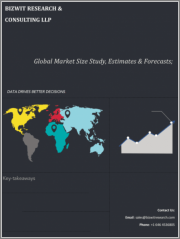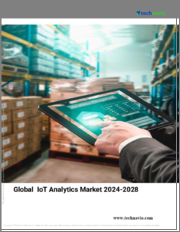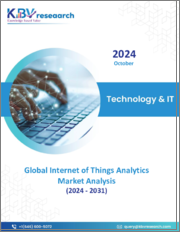
|
시장보고서
상품코드
1381673
세계의 IoT 애널리틱스 시장 규모 조사 및 예측 : 구성요소별, 전개별, 용도별, 산업별, 지역별 분석(2023-2030년)Global IoT Analytics Market Size study & Forecast, by Component, by Deployment, by Application, by Industry Vertical, and Regional Analysis, 2023-2030 |
||||||
IoT 애널리틱스는 사물인터넷(IoT) 기기 및 센서에서 생성된 데이터를 수집, 처리, 분석하는 과정입니다.
사물인터넷(Internet of Things)은 사람의 손을 거치지 않고 인터넷에서 데이터를 수집하고 교환할 수 있는 상호 연결된 장치, 사물, 기계의 네트워크로, IoT 애널리틱스는 IoT 장치에서 생성되는 방대한 양의 데이터를 활용하는 데 중요한 역할을 합니다. 를 활용하여 조직과 기업이 데이터 기반 의사결정을 내리고, 프로세스를 최적화하고, 사용자 경험을 개선하고, 전반적인 운영 효율성을 개선할 수 있도록 지원하는 데 중요한 역할을 합니다. 에 의해 확대되고 있습니다.
IoT 기기의 보급이 증가함에 따라, 이들 기기에서 생성되는 데이터는 기하급수적으로 증가하여 엄청난 양의 정보가 유입되고 있으며, IoT 애널리틱스를 통해 기업은 IoT 기기가 수집한 방대한 양의 데이터에서 실행 가능한 인사이트를 도출할 수 있습니다. 이러한 인사이트는 기업이 프로세스를 최적화하고, 생산성을 높이고, 다운타임을 줄이고, 확실한 의사결정을 내릴 수 있도록 도와줍니다. 또한, 커넥티드 카는 차량에 내장된 센서, GPS 장치, 카메라 및 기타 커넥티드 장치 등 다양한 소스에서 많은 양의 데이터를 생성합니다. 이 데이터에는 차량의 건강 상태, 운전 행동, 도로 상황 등에 대한 정보가 포함됩니다. 커넥티드카가 생성하는 방대하고 다양한 데이터는 IoT 애널리틱스에 큰 기회를 제공합니다. 이 소식통은 2025년까지 전 세계적으로 4억 대 이상의 커넥티드카가 운행될 것으로 예상하고 있으며, 이는 2021년 약 2억 3,700만 대의 커넥티드카가 증가한 것을 의미합니다. 이처럼 IoT 커넥티드 데이터 양의 증가와 전 세계 커넥티드 카의 도입이 증가하면서 IoT 애널리틱스 시장의 성장을 촉진하는 요인으로 작용하고 있습니다. 또한, 산업 자동화를 위한 IoT 애널리틱스의 채택, 기술 발전의 증가, 다양한 산업 분야의 IoT 지출 증가는 시장 성장의 새로운 기회를 창출하고 있습니다. 그러나 데이터 프라이버시 및 보안과 관련된 우려는 2023-2030년 예측 기간 동안 시장 성장을 저해하는 요인으로 작용하고 있습니다.
세계 IoT 애널리틱스 시장 조사에서 고려된 주요 지역은 아시아태평양, 북미, 유럽, 라틴아메리카, 중동 및 아프리카입니다. 북미는 주요 시장 진입 기업의 존재, 커넥티드 디바이스의 채택 증가, 다양한 최종사용자의 IoT 기술 채택에 대한 지출 증가, 데이터 생성 증가, 이 지역의 기술 발전 증가로 인해 2022년 시장을 주도했습니다. 반면, 아시아태평양은 디지털 기술 채택 증가, 커넥티드 디바이스 채택 증가, 이 지역의 공장 및 산업 부문의 스마트 기술 투자 증가 등의 요인으로 인해 빠른 속도로 성장할 것으로 예측됩니다.
이 조사의 목적은 최근 몇 년 동안 다양한 부문과 국가의 시장 규모를 정의하고 향후 몇 년 동안의 가치를 예측하는 것입니다. 이 보고서는 조사 대상 국가의 산업의 질적, 양적 측면을 모두 포함하도록 설계되었습니다.
또한 시장의 미래 성장을 규정하는 촉진요인과 과제와 같은 중요한 측면에 대한 자세한 정보도 제공합니다. 또한, 주요 기업의 경쟁 상황과 경쟁 환경에 대한 상세한 분석과 함께 이해관계자들이 투자할 수 있는 미시적 시장에서의 잠재적 기회도 포함합니다.
목차
제1장 주요 요약
제2장 세계의 IoT 애널리틱스 시장 정의와 범위
- 조사 목적
- 시장 정의와 범위
- 업계의 진화
- 조사 범위
- 조사 대상 연도
- 통화 환산율
제3장 세계의 IoT 애널리틱스 시장 역학
- IoT 애널리틱스 시장의 영향 분석(2020-2030년)
- 시장 성장 촉진요인
- IoT 데이터량 증가
- 커넥티드카와 스마트 시티의 출현
- 시장 과제
- 데이터 프라이버시와 보안에 관한 우려
- 시장 기회
- IoT 애널리틱스의 산업 자동화에 대한 채용
- 기술 진보 증가
- 각 업계의 IoT에 대한 지출 증가
- 시장 성장 촉진요인
제4장 세계의 IoT 애널리틱스 시장 산업 분석
- Porter's 5 Force 모델
- 공급 기업의 교섭력
- 구매자의 교섭력
- 신규 참여업체의 위협
- 대체품의 위협
- 경쟁 기업 간의 경쟁 관계
- Porter's 5 Force 영향 분석
- PEST 분석
- 정치
- 경제
- 사회
- 기술
- 환경
- 법률
- 주요 투자 기회
- 주요 성공 전략
- COVID-19 영향 분석
- 파괴적 동향
- 업계 전문가의 관점
- 애널리스트의 결론과 제안
제5장 IoT 애널리틱스 세계 시장 : 컴포넌트별
- 시장 현황
- IoT 애널리틱스 세계 시장 : 컴포넌트별, 실적 - 잠재성 분석
- IoT 애널리틱스 세계 시장, 컴포넌트별, 추정·예측, 2020-2030년
- IoT 애널리틱스 시장, 하위 부문별 분석
- 솔루션
- 서비스
제6장 IoT 애널리틱스 세계 시장 : 전개별
- 시장 현황
- IoT 애널리틱스 세계 시장 : 전개별, 실적 - 잠재성 분석
- IoT 애널리틱스 세계 시장 : 전개별, 추정·예측, 2020-2030년
- IoT 애널리틱스 시장, 하위 부문별 분석
- 클라우드
- 온프레미스
제7장 IoT 애널리틱스 세계 시장 : 용도별
- 시장 현황
- IoT 애널리틱스 세계 시장 : 용도별, 실적 - 잠재성 분석
- IoT 애널리틱스 세계 시장, 용도별, 추정·예측, 2020-2030년
- IoT 애널리틱스 시장, 하위 부문 분석
- 에너지 관리
- 예측·자산 관리
- 재고 관리
- 판매·고객 관리
- 빌딩 자동화
- 보안과 긴급사태 관리
- 인프라 관리
- 원격 감시
- 기타
제8장 IoT 애널리틱스 세계 시장 : 업계별
- 시장 현황
- IoT 애널리틱스 세계 시장 : 업계별, 실적 - 잠재성 분석
- IoT 애널리틱스 세계 시장 : 업계별, 추정·예측, 2020-2030년
- IoT 애널리틱스 시장, 하위 부문 분석
- 의료
- 정부·방위
- 제조업
- 에너지·유틸리티
- IT·통신
- 물류·운송
- 소매
- 기타
제9장 IoT 애널리틱스 세계 시장, 지역 분석
- 주요 국가
- 주요 신흥 국가
- IoT 애널리틱스 시장 지역별 시장 현황
- 북미
- 미국
- 컴포넌트별, 추정·예측, 2020-2030년
- 전개별, 추정·예측, 2020-2030년
- 용도별, 추정·예측, 2020-2030년
- 업계별, 추정·예측, 2020-2030년
- 캐나다
- 미국
- 유럽의 IoT 애널리틱스 시장 현황
- 영국
- 독일
- 프랑스
- 스페인
- 이탈리아
- 기타 유럽
- 아시아태평양의 IoT 애널리틱스 시장 현황
- 중국
- 인도
- 일본
- 호주
- 한국
- 기타 아시아태평양
- 라틴아메리카의 IoT 애널리틱스 시장 현황
- 브라질
- 멕시코
- 중동 및 아프리카
- 사우디아라비아
- 남아프리카공화국
- 기타 중동 및 아프리카
제10장 경쟁 정보
- 주요 기업 SWOT 분석
- 주요 시장 전략
- 기업 개요
- Microsoft Corporation
- 주요 정보
- 개요
- 재무(데이터 가용성에 따라 다름)
- 제품 개요
- Oracle Corporation
- Amazon Web Services, Inc.
- Cisco Systems, Inc
- International Business Machine Corporation
- SAP SE
- Accenture PLC
- Dell Technologies Inc
- Google LLC
- The Hewlett Packard Enterprise(HPE) Company
- Microsoft Corporation
제11장 조사 과정
- 조사 과정
- 데이터 광업
- 분석
- 시장 추정
- 검증
- 출판
- 조사 속성
- 조사 가정
IoT Analytics is a process of collecting, processing, and analyzing data generated by Internet of Things (IoT) devices and sensors. The Internet of Things is a network of interconnected devices, objects, and machines that can collect and exchange data over the internet without the need for human intervention. IoT Analytics plays a crucial role in leveraging the massive amounts of data generated by IoT devices, helping organizations and businesses make data-driven decisions, optimize processes, enhance user experiences, and improve overall operational efficiency. The IoT Analytics market is expanding because of factors such increasing volume of IoT data and emergence of connected cars and smart cities.
As the adoption of IoT devices continues to rise, the data generated by these devices grows exponentially, creating a massive influx of information. IoT analytics enables organizations to extract actionable insights from the massive volumes of data collected by IoT devices. These insights help businesses optimize processes, enhance productivity, reduce downtime, and make firm decisions. According to Statista in year 2019 the total data volume generated by IoT connection stood at 13.6 zetabytes and it is projected to reach at 79.4 zetabytes by year 2025. Furthermore, connected cars generate massive volumes of data from various sources, such as built-in sensors, GPS devices, cameras, and other connected devices within the vehicle. This data includes information about vehicle health, driving behavior, road conditions, and much more. The sheer volume and variety of data produced by connected cars present significant opportunities for IoT analytics. The same source projected that by year 2025, there would be over 400 million connected cars in operation across the globe which represent increased of some 237 million connected cars in year 2021. Thus, rising IoT connection data volume and rising adoption of connected cars across the world are some factors driving the growth of IoT analytics market. In addition, adoption of IoT analytics is industrial automation, increasing technological advancement and increasing IoT spending by various industries are creating new opportunities for market growth. However, concerns associated with data privacy and security stifles market growth throughout the forecast period of 2023-2030.
The key regions considered for the Global IoT Analytics Market study includes Asia Pacific, North America, Europe, Latin America, and Middle East & Africa. North America dominated the market in 2022 owing to presence of key market players, rising adoption of connected devices, rising spending on adoption of IoT technologies by various end users, rising data generation and rising technological advancement in the region. Whereas, Asia Pacific is projected to grow at a significant rate owing to factors such as rising adoption of digital technologies, rising adoption of connected devices, rising investment in smart technologies in factories and industrial sectors in the region.
Major market player included in this report are:
- Microsoft Corporation
- Oracle Corporation
- Amazon Web Services, Inc.
- Cisco Systems, Inc
- International Business Machine Corporation
- SAP SE
- Accenture PLC
- Dell Technologies Inc
- Google LLC
- The Hewlett Packard Enterprise (HPE) Company
Recent Developments in the Market:
- In October 2022, KTD SYNNEX introduced Data-IoTSolv in the Americas, a comprehensive suite of solutions designed to empower partners in harnessing the potential of the Internet of Things (IoT) and data analytics for accelerated business expansion. With Data-IoTSolv, resellers gain access to cutting-edge technologies spanning the entire IoT edge spectrum, including artificial intelligence (AI) and advanced analytics, enabling them to deliver top-notch services to their clients. This initiative aims to drive innovation and growth by leveraging the transformative power of IoT and data analytics in the business landscape.
- In May 2022, Kajeet, a prominent provider of wireless connectivity, software, and hardware solutions has introduced Sentinel Insights. This new cloud-based data analytics product serves as a powerful addition to Kajeet's flagship IoT management platform, Sentinel. By offering enhanced data analytics capabilities, Sentinel Insights empowers users to derive deeper insights and make informed decisions, bolstering the overall performance and value of Kajeet's IoT solutions for their diverse range of clients.
Global IoT Analytics Market Report Scope:
- Historical Data - 2020 - 2021
- Base Year for Estimation - 2022
- Forecast period - 2023-2030
- Report Coverage - Revenue forecast, Company Ranking, Competitive Landscape, Growth factors, and Trends
- Segments Covered - Component, Deployment, Application, Industry Vertical, Region
- Regional Scope - North America; Europe; Asia Pacific; Latin America; Middle East & Africa
- Customization Scope - Free report customization (equivalent up to 8 analyst's working hours) with purchase. Addition or alteration to country, regional & segment scope*
The objective of the study is to define market sizes of different segments & countries in recent years and to forecast the values to the coming years. The report is designed to incorporate both qualitative and quantitative aspects of the industry within countries involved in the study.
The report also caters detailed information about the crucial aspects such as driving factors & challenges which will define the future growth of the market. Additionally, it also incorporates potential opportunities in micro markets for stakeholders to invest along with the detailed analysis of competitive landscape and Component offerings of key players. The detailed segments and sub-segment of the market are explained below:
By Component:
- Software
- Services
By Deployment:
- Cloud
- On-Premise
By Application:
- Energy Management
- Predictive & Asset Management
- Inventory Management
- Sales & Customer Management
- Building Automation
- Security and Emergency Management
- Infrastructure Management
- Remote Monitoring
- Others
By Industry Vertical:
- Healthcare
- Government & Defense
- Manufacturing
- Energy & Utilities
- IT & Telecom
- Logistics & Transportation
- Retail
- Others
By Region:
- North America
- U.S.
- Canada
- Europe
- UK
- Germany
- France
- Spain
- Italy
- ROE
- Asia Pacific
- China
- India
- Japan
- Australia
- South Korea
- RoAPAC
- Latin America
- Brazil
- Mexico
- Middle East & Africa
- Saudi Arabia
- South Africa
- Rest of Middle East & Africa
Table of Contents
Chapter 1. Executive Summary
- 1.1. Market Snapshot
- 1.2. Global & Segmental Market Estimates & Forecasts, 2020-2030 (USD Billion)
- 1.2.1. IoT Analytics Market, by Region, 2020-2030 (USD Billion)
- 1.2.2. IoT Analytics Market, by Component, 2020-2030 (USD Billion)
- 1.2.3. IoT Analytics Market, by Deployment, 2020-2030 (USD Billion)
- 1.2.4. IoT Analytics Market, by Application, 2020-2030 (USD Billion)
- 1.2.5. IoT Analytics Market, by Industry Vertical, 2020-2030 (USD Billion)
- 1.3. Key Trends
- 1.4. Estimation Methodology
- 1.5. Research Assumption
Chapter 2. Global IoT Analytics Market Definition and Scope
- 2.1. Objective of the Study
- 2.2. Market Definition & Scope
- 2.2.1. Industry Evolution
- 2.2.2. Scope of the Study
- 2.3. Years Considered for the Study
- 2.4. Currency Conversion Rates
Chapter 3. Global IoT Analytics Market Dynamics
- 3.1. IoT Analytics Market Impact Analysis (2020-2030)
- 3.1.1. Market Drivers
- 3.1.1.1. Increasing volume of IoT data
- 3.1.1.2. Emergence of connected cars and smart cities
- 3.1.2. Market Challenges
- 3.1.2.1. Concerns associated with data privacy and security
- 3.1.3. Market Opportunities
- 3.1.3.1. Adoption of IoT analytics is industrial automation
- 3.1.3.2. Increasing technological advancement
- 3.1.3.3. Increasing IoT spending by various industries verticals
- 3.1.1. Market Drivers
Chapter 4. Global IoT Analytics Market Industry Analysis
- 4.1. Porter's 5 Force Model
- 4.1.1. Bargaining Power of Suppliers
- 4.1.2. Bargaining Power of Buyers
- 4.1.3. Threat of New Entrants
- 4.1.4. Threat of Substitutes
- 4.1.5. Competitive Rivalry
- 4.2. Porter's 5 Force Impact Analysis
- 4.3. PEST Analysis
- 4.3.1. Political
- 4.3.2. Economical
- 4.3.3. Social
- 4.3.4. Technological
- 4.3.5. Environmental
- 4.3.6. Legal
- 4.4. Top investment opportunity
- 4.5. Top winning strategies
- 4.6. COVID-19 Impact Analysis
- 4.7. Disruptive Trends
- 4.8. Industry Expert Perspective
- 4.9. Analyst Recommendation & Conclusion
Chapter 5. Global IoT Analytics Market, by Component
- 5.1. Market Snapshot
- 5.2. Global IoT Analytics Market by Component, Performance - Potential Analysis
- 5.3. Global IoT Analytics Market Estimates & Forecasts by Component 2020-2030 (USD Billion)
- 5.4. IoT Analytics Market, Sub Segment Analysis
- 5.4.1. Solution
- 5.4.2. Services
Chapter 6. Global IoT Analytics Market, by Deployment
- 6.1. Market Snapshot
- 6.2. Global IoT Analytics Market by Deployment, Performance - Potential Analysis
- 6.3. Global IoT Analytics Market Estimates & Forecasts by Deployment 2020-2030 (USD Billion)
- 6.4. IoT Analytics Market, Sub Segment Analysis
- 6.4.1. Cloud
- 6.4.2. On-premise
Chapter 7. Global IoT Analytics Market, by Application
- 7.1. Market Snapshot
- 7.2. Global IoT Analytics Market by Application, Performance - Potential Analysis
- 7.3. Global IoT Analytics Market Estimates & Forecasts by Application 2020-2030 (USD Billion)
- 7.4. IoT Analytics Market, Sub Segment Analysis
- 7.4.1. Energy Management
- 7.4.2. Predictive & Asset Management
- 7.4.3. Inventory Management
- 7.4.4. Sales & Customer Management
- 7.4.5. Building Automation
- 7.4.6. Security and Emergency Management
- 7.4.7. Infrastructure Management
- 7.4.8. Remote Monitoring
- 7.4.9. Others
Chapter 8. Global IoT Analytics Market, by Industry Vertical
- 8.1. Market Snapshot
- 8.2. Global IoT Analytics Market by Industry Vertical, Performance - Potential Analysis
- 8.3. Global IoT Analytics Market Estimates & Forecasts by Industry Vertical 2020-2030 (USD Billion)
- 8.4. IoT Analytics Market, Sub Segment Analysis
- 8.4.1. Healthcare
- 8.4.2. Government & Defense
- 8.4.3. Manufacturing
- 8.4.4. Energy & Utilities
- 8.4.5. IT & Telecom
- 8.4.6. Logistics & Transportation
- 8.4.7. Retail
- 8.4.8. Others
Chapter 9. Global IoT Analytics Market, Regional Analysis
- 9.1. Top Leading Countries
- 9.2. Top Emerging Countries
- 9.3. IoT Analytics Market, Regional Market Snapshot
- 9.4. North America IoT Analytics Market
- 9.4.1. U.S. IoT Analytics Market
- 9.4.1.1. Component breakdown estimates & forecasts, 2020-2030
- 9.4.1.2. Deployment breakdown estimates & forecasts, 2020-2030
- 9.4.1.3. Application breakdown estimates & forecasts, 2020-2030
- 9.4.1.4. Industry Vertical breakdown estimates & forecasts, 2020-2030
- 9.4.2. Canada IoT Analytics Market
- 9.4.1. U.S. IoT Analytics Market
- 9.5. Europe IoT Analytics Market Snapshot
- 9.5.1. U.K. IoT Analytics Market
- 9.5.2. Germany IoT Analytics Market
- 9.5.3. France IoT Analytics Market
- 9.5.4. Spain IoT Analytics Market
- 9.5.5. Italy IoT Analytics Market
- 9.5.6. Rest of Europe IoT Analytics Market
- 9.6. Asia-Pacific IoT Analytics Market Snapshot
- 9.6.1. China IoT Analytics Market
- 9.6.2. India IoT Analytics Market
- 9.6.3. Japan IoT Analytics Market
- 9.6.4. Australia IoT Analytics Market
- 9.6.5. South Korea IoT Analytics Market
- 9.6.6. Rest of Asia Pacific IoT Analytics Market
- 9.7. Latin America IoT Analytics Market Snapshot
- 9.7.1. Brazil IoT Analytics Market
- 9.7.2. Mexico IoT Analytics Market
- 9.8. Middle East & Africa IoT Analytics Market
- 9.8.1. Saudi Arabia IoT Analytics Market
- 9.8.2. South Africa IoT Analytics Market
- 9.8.3. Rest of Middle East & Africa IoT Analytics Market
Chapter 10. Competitive Intelligence
- 10.1. Key Company SWOT Analysis
- 10.1.1. Company 1
- 10.1.2. Company 2
- 10.1.3. Company 3
- 10.2. Top Market Strategies
- 10.3. Company Profiles
- 10.3.1. Microsoft Corporation
- 10.3.1.1. Key Information
- 10.3.1.2. Overview
- 10.3.1.3. Financial (Subject to Data Availability)
- 10.3.1.4. Product Summary
- 10.3.1.5. Recent Developments
- 10.3.2. Oracle Corporation
- 10.3.3. Amazon Web Services, Inc.
- 10.3.4. Cisco Systems, Inc
- 10.3.5. International Business Machine Corporation
- 10.3.6. SAP SE
- 10.3.7. Accenture PLC
- 10.3.8. Dell Technologies Inc
- 10.3.9. Google LLC
- 10.3.10. The Hewlett Packard Enterprise (HPE) Company
- 10.3.1. Microsoft Corporation
Chapter 11. Research Process
- 11.1. Research Process
- 11.1.1. Data Mining
- 11.1.2. Analysis
- 11.1.3. Market Estimation
- 11.1.4. Validation
- 11.1.5. Publishing
- 11.2. Research Attributes
- 11.3. Research Assumption



















